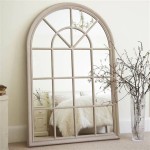Do Tilted Mirrors Make You Look Bigger?
The question of whether tilted mirrors make a person appear larger is a common one, often arising in the context of dressing rooms and home décor. The short answer is no, a tilted mirror does not inherently change body mass. The perceived change in size stems from the distortion of the reflected image caused by the angle of the mirror.
To understand this phenomenon, it's crucial to grasp the basic principles of reflection. A flat, vertical mirror reflects light rays at the same angle they strike the surface. This results in a virtual image that is the same size and shape as the object being reflected. However, when the mirror is tilted, the angles of reflection change. This alteration in reflection angles leads to a distorted image, stretching or compressing different parts of the reflection depending on the tilt's direction and degree.
Imagine a rectangular object placed in front of a tilted mirror. The top of the object is further away from the mirror than the bottom. The reflected light rays from the top travel a longer distance to reach the observer's eye compared to the rays from the bottom. This difference in distance creates the illusion of elongation in the reflected image.
The degree of distortion is directly proportional to the angle of the mirror's tilt. A slight tilt will cause minimal distortion, while a steeper tilt will result in a more pronounced stretching or compression of the reflected image. The specific parts of the image that appear stretched or compressed depend on the direction of the tilt. A mirror tilted forward will appear to elongate the lower part of the reflected image, while a mirror tilted backward will appear to elongate the upper part.
This principle applies to reflections of the human body as well. A tilted mirror can create the illusion of a longer torso, shorter legs, or a wider frame, depending on the angle and direction of the tilt. It's important to remember that these changes are purely visual distortions and do not reflect any actual alteration in body size or proportions.
The phenomenon of distorted reflections is frequently encountered in funhouse mirrors, which are intentionally designed with curved or angled surfaces to create exaggerated and comical distortions. These mirrors exploit the same principles of reflection as tilted flat mirrors, but with more dramatic results due to their non-uniform surfaces.
In dressing rooms, mirrors are ideally placed vertically to provide an accurate reflection of the body. However, slight variations in installation or accidental tilting can introduce subtle distortions. These distortions can sometimes lead to misperceptions about body image, causing individuals to perceive themselves as larger or smaller than they actually are. Therefore, awareness of this optical illusion is crucial for maintaining a realistic body image.
The perception of size is also influenced by other factors besides mirror angle. Lighting conditions, the distance between the observer and the mirror, and the presence of other objects in the reflected scene can all contribute to how one perceives their size in the reflection. For example, dim lighting can create shadows that distort the perceived shape of the body, while a mirror placed too close can magnify certain features and create a distorted impression of overall size.
Furthermore, psychological factors can also influence body image perception. Pre-existing insecurities or societal pressures regarding body image can exacerbate the impact of distorted reflections, leading to negative self-perception. It is important to recognize that the image reflected in a tilted mirror is not an accurate representation of reality and to focus on objective measures of body size and proportions.
In conclusion, tilted mirrors do not make one look bigger in the sense of altering actual body mass. They create an optical illusion that distorts the reflected image, leading to a misperception of size and proportions. Understanding the principles of reflection and the factors that influence perception can help individuals interpret reflections accurately and maintain a realistic body image.

Proof You Do Look Diffe In Every Changing Room Mirror Amanda Platell Writes Daily Mail

Why Do I Look Diffe In Mirrors 5 Common Reasons

Why Do I Look Diffe In Mirrors 5 Common Reasons
Why Do We Look Fitter In Gym Mirrors Quora

Why Do I Look Diffe In Mirrors 5 Common Reasons

New Skinny Mirror Makes You Look 10 Pounds Thinner

Are Skinny Mirrors Being Used In Popular Retailers Dressing Rooms I Decided To Find Out

Here S How Fitting Room Mirrors Make You Look A Lot Better Than Do
Why Is It That There Are Mirrors Make You Look Fat And Some Thin Which The Real One Quora
Why Do We Look Fitter In Gym Mirrors Quora








